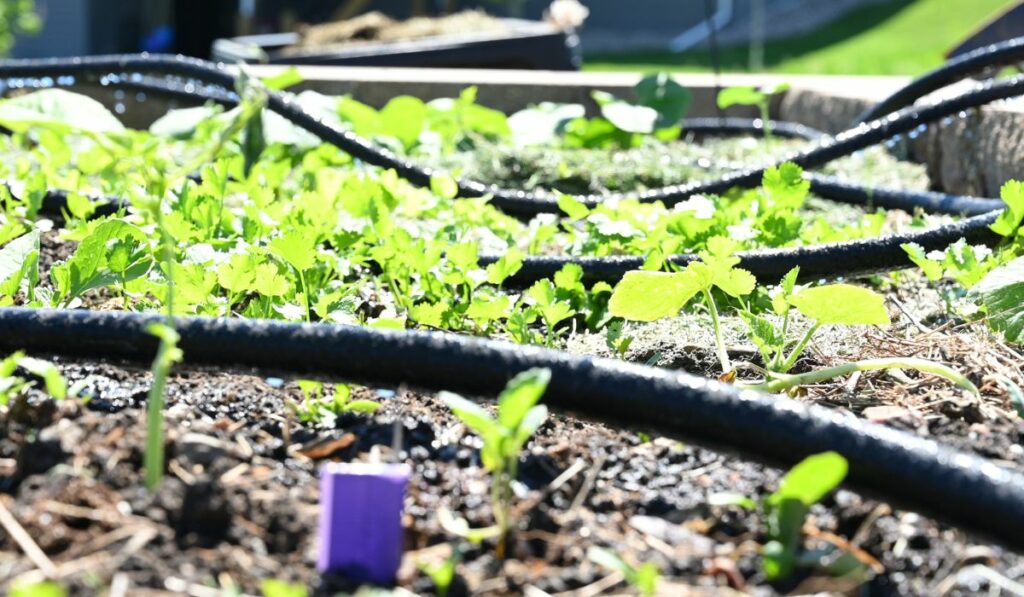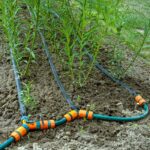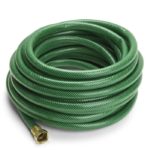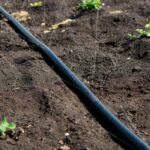If you’ve done your research, you probably know that a soaker hose can make it much easier to maintain your garden, especially since it doesn’t require constant monitoring Plus, a soaker hose helps save time and money, making it a great alternative to using traditional sprinklers or watering by hand. But what exactly is a soaker hose, and how do you use one?
A soaker hose is a porous garden hose. Water slowly seeps out of the holes and goes down to the plant roots. You can use it to water a small flower bed, rows of vegetables, and even perennial borders. To install a soaker hose, just hook it up to the water source, lay it out, and turn on the tap.
If you’re still on the fence about using a soaker hose, we’ve got you covered. Despite resembling a garden hose, a soaker hose is quite different — and we’ll see why in just a bit. We’ll also go over its uses, how you can install one, and whether you need to call for professional help.
What Is a Soaker Hose?

A soaker hose looks pretty much like a garden hose; the only difference is that it has small pores along its whole length that resemble the pores on our skin. Water slowly seeps out of these pores in the hose.
When placed in the garden, the low water pressure of the soaker hose ensures efficient water flow from the hose straight down to the plant’s base. So, with a soaker hose, more water goes right down to the roots and less of it goes to places where it’ll evaporate quickly.
Another great thing about soaker hoses is the convenience they provide. They’re easy to move around, and in most cases, you just have to place them; once you’re done, they’ll do the rest of the work. They also require very little monitoring and maintenance.
There are two kinds of soaker hoses, and you can bury both of them under 1-2 inches of mulch. But if you go any deeper than that, you risk damaging the hose.
Flat hoses
Many gardeners prefer flat hoses like this one from Linex (on Amazon) for watering straight and long rows of summer plants. They’re usually available in PVC, polyurethane, rubber, and vinyl and are the most suitable for laying along straight rows instead of snaking around bushes, trees, and plants.
However, flat hoses have some drawbacks. Instead of having holes on all the sides, they typically have holes present on just one side, so they pretty much act like sprinklers. You also can’t wind these hoses since doing so can cause kinks and restrict the flow of water.
Round hoses
Round hoses like this one from Dramm (on Amazon) are more versatile since you can use them on both straight rows and snake them around multiple trees and bushes without causing any kinks. And even though they’re more expensive than their flat counterparts, they’re more durable, flexible, and long-lasting, so they basically pay for themselves.
Who Is a Soaker Hose Best For?
Soaker hoses are best for home gardeners and those new to gardening, especially since they stay stationary. For that reason, you don’t need to drag these heavy hoses around whenever you want to water your plants.
They’re also available in a range of sizes – you can get 15-foot hoses that are best for small flower beds or even 100-foot hoses if you want to water long rows of vegetables and long perennial borders. They’re also ideal for watering bushes, shrubs, flower beds, and flowers planted in pots or raised beds.
How Do You Install a Soaker Hose?
It’s quite easy to install a soaker hose with these six steps:
- If you have a brand-new soaker hose, first unwind it and leave it under the sun for around an hour. Doing so will loosen the tight coil that the hose was wound in and will make placing it much easier.
- Take out the end cap and attach the hose to a water source.
- Switch on the water source and let the water run for a few minutes to flush the hose. You should flush hoses not only before using a new hose, but also once or twice a year to get rid of the built-up debris.
- Put the end cap back.
- If the area you want to water is near the faucet, then you can directly connect it to the faucet. But if you need to extend the soaker hose so that it reaches the area you want to water, you’ll have to first connect a garden hose to the main water source. Then you can connect the other end of the garden hose with the soaker hose.
- Now, stretch the hose and switch on the water. Adjust the water pressure until water slowly but steadily drips out of the hose.
Where should you place the soaker hose?

With a little bit of planning, you can lay down your soaker hose so that it waters your flower bed or garden efficiently. Here are some tips to keep in mind:
- You should lay the soaker hose in a straight line along the rows if you have shrubs, vegetables, and flowers planted in a line. If they’re not in a straight line, then it’s better if you snake the hose around individual plants.
- In the case of established plants, lay the soaker hose about 2 inches from the stems. But reduce that spacing if you have new plants since they have more shallow roots.
- For plants that require more water, make sure to arrange extra loops.
- Also, be mindful of the soil. In the case of sandy soil, wind the hose roughly 1 foot apart in each row. For loamy or clay soil, make sure your hose is roughly 2 feet apart.
- Use garden pins or staples like these from Whonline (on Amazon) to hold the hose in place and prevent it from moving.
- Cover the hose with around 1-2 inches of mulch to prevent the loss of moisture due to evaporation and protect the soaker hose from sun damage.
How to Extend the Soaker Hose
For a landscaped area or a large flower garden, you’ll probably need multiple soaker hoses. And while it’s possible to connect multiple hoses, keep in mind that the one nearest to the source of water will give out the most water.
Accordingly, the end of the connected hoses will output less water, causing uneven water distribution and affecting plant growth. One way to overcome this problem is to divide your yard into zones and have around 100-150 feet of hose for each zone.
Also, install a hose splitter that features a shut-off valve to switch the water flow between different hoses. This way, you’ll be able to ensure even water distribution throughout your yard or garden.
What Does a Soaker Hose Cost?
Soaker hoses are one of the simplest and cheapest options for watering your garden. The cost of installing a soaker hose depends on the length you need and if you need anything else to complete the installation like connectors or pipes. Typically, 50 feet of soaker hose tubing costs around $20.
Should You Install a Soaker Hose Yourself or Hire a Professional?
There’s no need to hire a professional to install a soaker hose. It’s really easy, and even if you’ve never done it, you’ll be fine as long as you plan it out correctly. Just make sure you’re mindful of the spacing you need to give and whether you need a flat hose or a round one.








